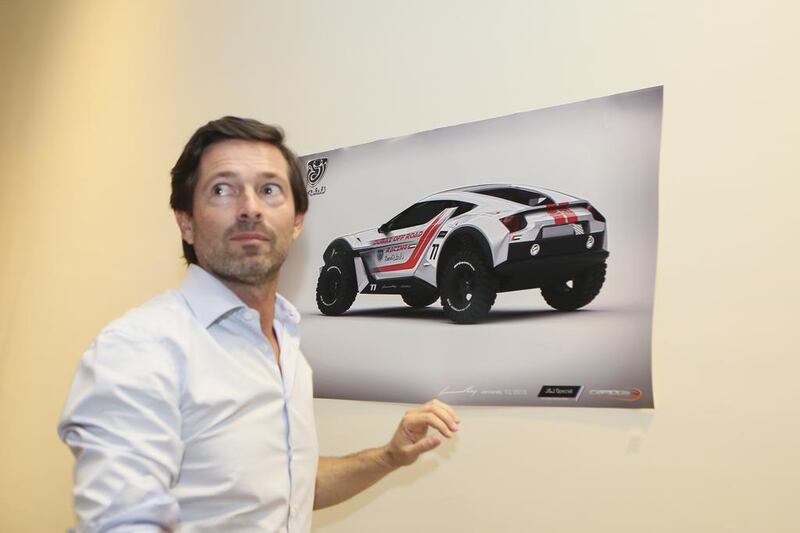DUBAI // The men behind the UAE’s first locally-built, purposefully-designed desert racing car are calling on all Emiratis to take part in their proposed desert racing series.
Unveiling details and specifications of the Zarooq Sand Racer at an exclusive event at Sofitel the Palm Resort in Dubai on Tuesday, Zarooq co-founder Mohammed Al Qadi said his team hoped to groom the next generation to compete internationally at the highest levels of motorsport.
With the car’s key components designed, made and assembled in the UAE, co-founders Al Qadi, Iannis Mardell and Bruno Lafitte also hope that the Zarooq will help to develop local supply chains and help build the skills necessary for the manufacturing of high-performance cars on a larger scale.
The first Zarooq will be ready to hit the dunes in January of 2016, and will boast a top speed of about 200 kph. Powering the car will be a 3.5l V6 engine, which is combined with a six-speed automatic gearbox with paddle shifters.
But pure horsepower is not the only thing that makes the Zarooq suited to fast desert driving. A properly designed and tuned suspension is critical for delivering performance, and this is where technical partners Campos Racing stepped in, bringing with them the engineering knowledge gathered over decades of competing in various racing formulas.
Campos’ Philippe Gautheron said his team also worked on the car’s transmission.
“Our racing experience helped us a lot,” he said. “We like to work on beautiful things, and this car is beautiful.”
The Zarooq’s designer, Anthony Jannarelly of JJSpecial, elaborated on some of the design choices he made.
“It had to be fit for purpose, of course, hence the significant ground clearance, limited overhang or the room necessary for significant suspension travel,” he said.
“It also had to meet the standards to be road legal, yet we clearly focused on designing a car that is unique, aggressive and we hope, one day, iconic.”
Frederic Juillot, the other half of JJSpecial and the man in charge of the Zarooq manufacturing workshop, said the car is being manufactured with state-of-the-art components.
“The chassis is laser-cut, and we’re using a lot of carbon fibre and fibre glass,” he said. “It’s all handmade.”
Mardell said the Zarooq is different from any other car out there, because it is specially tailored for the desert environments of the UAE.
“It has a tremendous power-to-weight ratio and the right combination of performance and practicality. It can race in the desert but also be used on the road.”
Another feature that is virtually non-existent in the world of motorsport is the inclusion of air-conditioning, a non-negotiable in UAE weather.
Asked whether this would have any impact on power, the technical team explained that the relatively small cabin, combined with the small size of the AC unit and the power of the engine, meant that any such effect would be negligible.
Campos founder and former Formula 1 driver Adrián Campos also said that thanks to new innovations, there’s almost no loss of power that comes with the addition of AC. He said this is a welcome change from his days as a racer, when drivers had to just grit their teeth and get on with the job, often at the cost of performance.
With the first Zarooq almost ready to take to the roads and dunes, the team is already looking to the future.
“We will be looking at how to further improve the power-to-weight ratio, both by further reducing the car’s weight and increasing engine power,” Mardell said. “We’re also looking at using electric and hybrid power trains, developing a four-wheel-drive version of the car, as well as a four-seater.”
newsdesk@thenational.ae






